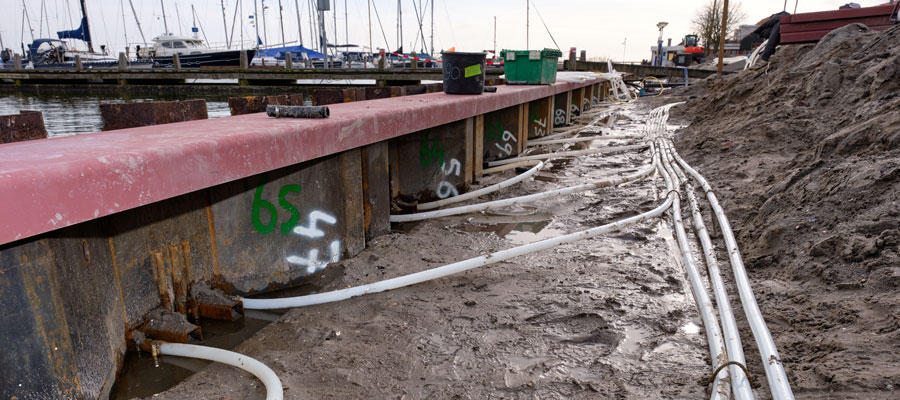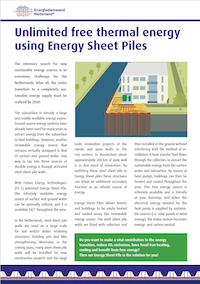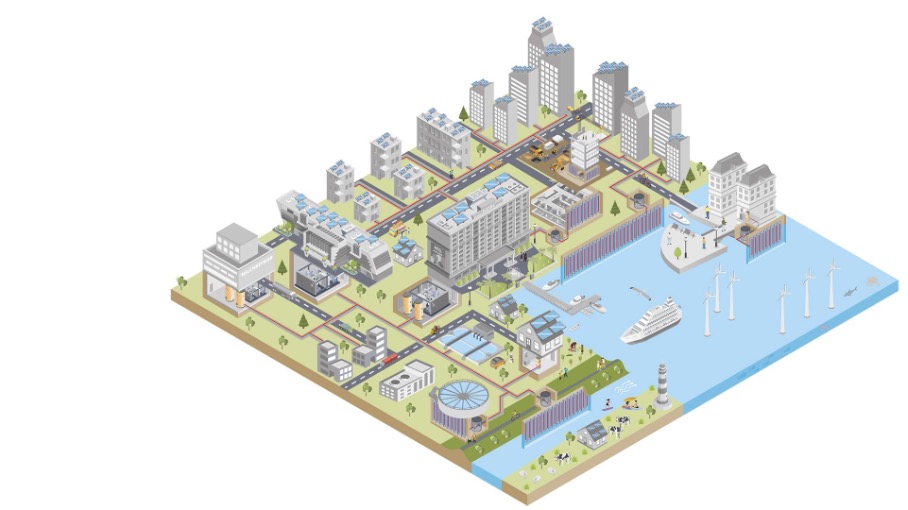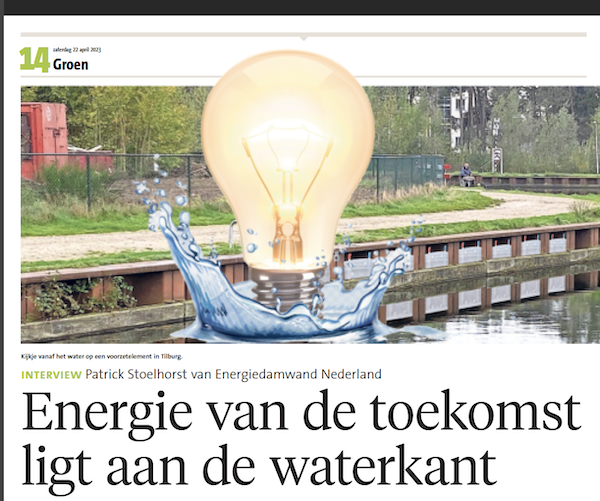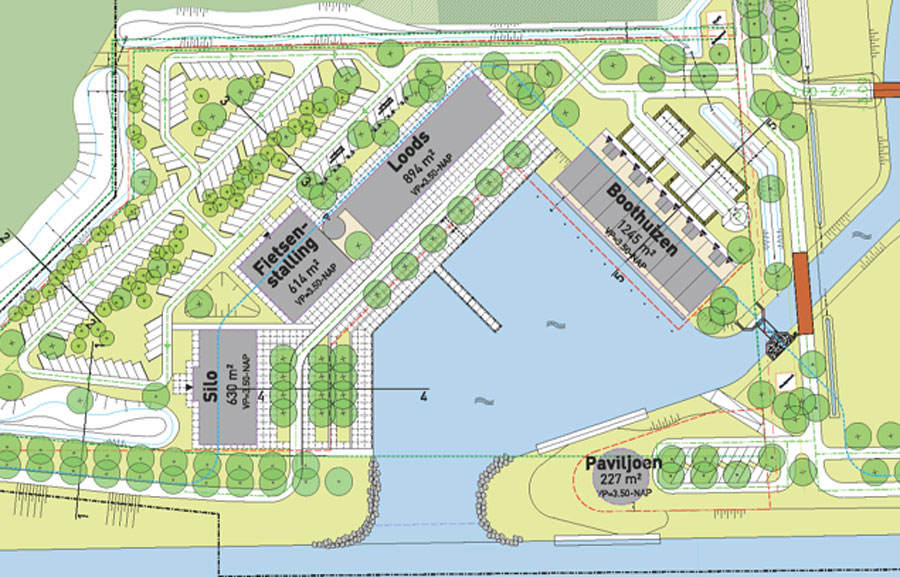The numerous innovation awards that Energy Sheet Piles have received in their short existence, has enabled an intensive monitoring program. This demonstrated that the steel sheet pile heat exchanger is an efficient source for powering a heat pump, offering a promising prospect in countries surrounded by water, like the Netherlands.
They had some reservations about the introduction at Infratech exhibition in 2019. In a corner of their booth, Gooimeer had set up a makeshift model of a sheet pile panel with steel pipes. This idea came from the German company SPS Energy, with whom they had been in discussion for several years leading up to this point.
SPS had already used the sheet pile as a heat exchanger in two projects in Germany. Connected to a heat pump, it provided heating for two buildings behind a quay wall: a house and a small hotel. However, those projects had never received much attention, and the technology seemed at risk of being forgotten.
License
This changed with Gooimeer’s presentation at the trade fair in Rotterdam. The sheet pile supplier Gooimeer engaged in discussions with geotechnical consulting firm CRUX. They decided to obtain the license for the technology and establish a dedicated company: Energiedamwand Nederland BV.
Earlier this year, Gooimeer’s Managing Director, Patrick Stoelhorst, appeared at Infratech exhibition with greater confidence. The same was true a few weeks later at the Bouwbeurs in Utrecht a construction exhibition. In the hall where all heat pump manufacturers showcased their latest innovations, Energiedamwand Nederland presented its alternative to the outdoor unit or ground source heat pumps.
Not only was the model in the booth more polished than four years earlier, but Stoelhorst could also present several completed projects in the Netherlands. These projects were invariably accompanied by intensive monitoring programs, which significantly increased knowledge about the technology’s performance. Moreover, Energiedamwand Nederland developed a ‘add on element’ (a retrofit unit), allowing existing sheet pile structures to be activated. The pipes are placed on the water side of the sheet pile in a protective box and perforations in the wall ensure that enough water flows along the pipes for heat exchange, without the risk of damage from off-course ships or other floating objects.
1 to 2 kW per unit
According to Stoelhorst, the heat exchange is highly effective. On average, he believes you can expect a capacity of 1-2 kW per sheet pile unit. This means that, with six units and a heat pump, a well-insulated home can be heated and supplied with hot water. The heating system easily achieves a Coefficient of Performance (COP) of 5.0. This means that five times more heat energy is delivered than the needed electrical energy to run the heat pump. After all the monitoring conducted in initial projects, Stoelhorst can back up these claims.
An unlimited energy buffer
According to Stoelhorst, the part directly in contact with the water is particularly effective. The heat transfer can be up to ten times faster there than in the part of the structure entirely surrounded by soil. But since that part typically makes up about two-thirds of the sheet pile, it also contributes substantially. “This is included in the claim of 1 to 2 kW per unit.”
Stoelhorst: “Everyone understands that the exact yield and efficiency depend on various factors, such as the precise dimensions of the sheet pile, soil composition, and the flow rate of the water along the quay. But with 1 to 2 kW per unit, we aim to provide a realistic starting point for a discussion. This gives people an idea of what to expect. As we work on our projects and determine the specific conditions, this becomes more precise.”
Payback Period
Stoelhorst extrapolates from the research results to conclude that the CO2 emissions generated during the production of the steel sheet piles, when used as heat exchangers, are already recouped within three years. This has also been demonstrated in a Life Cycle Assessment (LCA) study. “When you tell people that, their opinion on sheet piles changes. Especially when you consider that a sheet pile typically has a lifespan of 80 or 100 years. It even changes their perspective on the steel industry as a whole.”
The largest project completed in the Netherlands in recent years, is located in the marina of Enkhuizen. There, about 125 meters of quay wall have incorporated this new technology. Currently, about 25 meters are used to heat a large restaurant on the quay. This coming spring, the harbor building will also be connected and other buildings are also in the pipeline. The marina ensures that the sheet pile heat exchanger, in which it invested when the quay wall needed reinforcement, is increasingly utilized.
Stoelhorst points out the opportunities presented by the massive quay replacement challenge that the Netherlands is facing. “Of course, not all quay reconstruction are done with sheet piles, and even when they are, they are often equipped with a “brickwork frontpanel” to maintain the traditional city look. However, that front panel typically ends about half a meter below the waterline. The rest of the structure can be effectively utilized for heat harvesting.”
Another fancy application of the energy sheet pile took place in It Swettehûs in Leeuwarden. This is a central control station for the operation of around forty bridges in the province of Friesland. The office, with approximately twenty workstations, is heated using the energy sheet piles located in the adjacent harbor. The thermal pipes are even applied to reused sheet piles. In Zuid-Holland, the province installed several Energy Sheet Piles along the Rijn-Schiekanaal, near the village of ‘De Zweth’, under Delft. This is a current research project.
Subsidy
Thanks to recently secured subsidies within the ‘Kansen voor West’ (Opportunities for the West) program, five new studies are on the horizon to further advance the system’s knowledge. A CRUX employee is conducting complex finite element calculations of the systems and comparing them to the measurement results being collected. This is part of a doctoral research project.
The new projects include one in the port of Almere, one in Maarssen, one in Greenvillage in Delft, one in Enkhuizen, and one in the sea port of Scheveningen. In the latter case, the effectiveness in a saltwater environment subject to tidal effects will be examined. According to Stoelhorst, it is justified to expect that the system will be just as effective as in freshwater. “But the reality is that it’s better to demonstrate such matters to alleviate any reservations future clients might have.”
Stoelhorst: “As sheet pile traders, our focus was naturally on the sale of tons of steel. But kilograms are increasingly taking a back seat and being displaced by kilowatts.”

